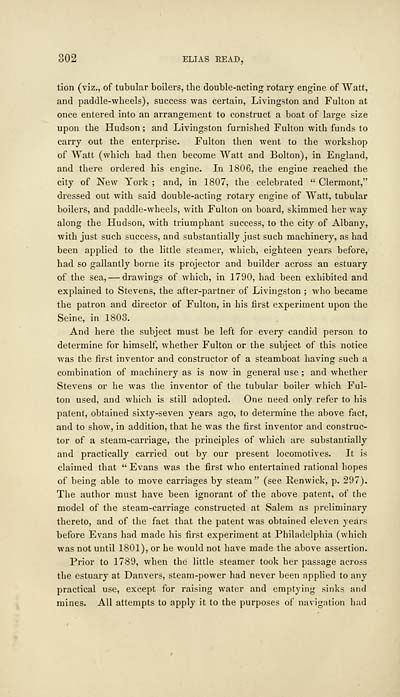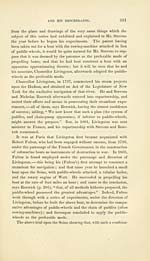History of the Reed family in Europe and America
(318) Page 302
Download files
Complete book:
Individual page:
Thumbnail gallery: Grid view | List view

302
tion (viz., of tubular boilers, the double-acting rotary engine of Watt,
and paddle-wheels), success was certain, Livingston and Fulton at
once entered into an arrangement to construct a boat of large size
upon the Hudson ; and Livingston furnished Fulton with funds to
carry out the enterprise. Fulton then went to the workshop
of "Watt (which had then become Watt and Bolton), in England,
and there ordered his engine. In 1806, the engine reached the
city of New York ; and, in 1807, the celebrated " Clermont,"
dressed out with said double-acting rotary engine of Watt, tubular
boilers, and paddle-wheels, with Fulton on board, skimmed her way
along the Hudson, with triumphant success, to the city of Albany,
with just such success, and substantially just such machinery, as had
been applied to the little steamer, which, eighteen years before,
had so gallantly borne its projector and builder across an estuary
of the sea, — drawings of which, in 1790, had been exhibited and
explained to Stevens, the after-partner of Livingston ; who became
the patron and director of Fulton, in his first experiment upon the
Seine, in 1803.
And here the subject must be left for every candid person to
determine for himself, whether Fulton or the subject of this notice
was the first inventor and constructor of a steamboat having such a
combination of machinery as is now in general use ; and whether
Stevens or he was the inventor of the tubular boiler which Ful-
ton used, and which is still adopted. One need only refer to his
patent, obtained sixty-seven years ago, to determine the above fact,
and to show, in addition, that he was the first inventor and construc-
tor of a steam-carriage, the principles of which are substantially
and practically carried out by our present locomotives. It is
claimed that "Evans was the first who entertained rational hopes
of being able to move carriages by steam " (see Eenwick, p. 297).
The author must have been ignorant of the above patent, of the
model of the steam-carriage constructed at Salem as preliminary
thereto, and of the fact that the patent was obtained eleven years
before Evans had made his first experiment at Philadelphia (which
was not until 1801), or he would not have made the above assertion.
Prior to 1789, when the little steamer took her passage across
the estuary at Danvers, steam-power had never been applied to any
practical use, except for raising water and emptying sinks and
mines. All attempts to apply it to the purposes of navigation had
tion (viz., of tubular boilers, the double-acting rotary engine of Watt,
and paddle-wheels), success was certain, Livingston and Fulton at
once entered into an arrangement to construct a boat of large size
upon the Hudson ; and Livingston furnished Fulton with funds to
carry out the enterprise. Fulton then went to the workshop
of "Watt (which had then become Watt and Bolton), in England,
and there ordered his engine. In 1806, the engine reached the
city of New York ; and, in 1807, the celebrated " Clermont,"
dressed out with said double-acting rotary engine of Watt, tubular
boilers, and paddle-wheels, with Fulton on board, skimmed her way
along the Hudson, with triumphant success, to the city of Albany,
with just such success, and substantially just such machinery, as had
been applied to the little steamer, which, eighteen years before,
had so gallantly borne its projector and builder across an estuary
of the sea, — drawings of which, in 1790, had been exhibited and
explained to Stevens, the after-partner of Livingston ; who became
the patron and director of Fulton, in his first experiment upon the
Seine, in 1803.
And here the subject must be left for every candid person to
determine for himself, whether Fulton or the subject of this notice
was the first inventor and constructor of a steamboat having such a
combination of machinery as is now in general use ; and whether
Stevens or he was the inventor of the tubular boiler which Ful-
ton used, and which is still adopted. One need only refer to his
patent, obtained sixty-seven years ago, to determine the above fact,
and to show, in addition, that he was the first inventor and construc-
tor of a steam-carriage, the principles of which are substantially
and practically carried out by our present locomotives. It is
claimed that "Evans was the first who entertained rational hopes
of being able to move carriages by steam " (see Eenwick, p. 297).
The author must have been ignorant of the above patent, of the
model of the steam-carriage constructed at Salem as preliminary
thereto, and of the fact that the patent was obtained eleven years
before Evans had made his first experiment at Philadelphia (which
was not until 1801), or he would not have made the above assertion.
Prior to 1789, when the little steamer took her passage across
the estuary at Danvers, steam-power had never been applied to any
practical use, except for raising water and emptying sinks and
mines. All attempts to apply it to the purposes of navigation had
Set display mode to:
![]() Universal Viewer |
Universal Viewer | ![]() Mirador |
Large image | Transcription
Mirador |
Large image | Transcription
Images and transcriptions on this page, including medium image downloads, may be used under the Creative Commons Attribution 4.0 International Licence unless otherwise stated. ![]()
| Histories of Scottish families > History of the Reed family in Europe and America > (318) Page 302 |
|---|
| Permanent URL | https://digital.nls.uk/94794435 |
|---|
| Description | A selection of almost 400 printed items relating to the history of Scottish families, mostly dating from the 19th and early 20th centuries. Includes memoirs, genealogies and clan histories, with a few produced by emigrant families. The earliest family history goes back to AD 916. |
|---|

